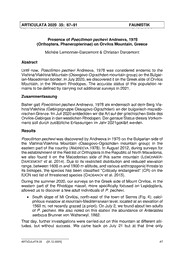
Presence of Poecilimon pechevi Andreeva, 1978 (Orthoptera, Phaneropterinae) on Orvilos Moutain, Greece PDF
Preview Presence of Poecilimon pechevi Andreeva, 1978 (Orthoptera, Phaneropterinae) on Orvilos Moutain, Greece
ARTICULATA 2020 35: 87–91 FAUNISTIK Presence of Poecilimon pechevi Andreeva, 1978 (Orthoptera, Phaneropterinae) on Orvilos Mountain, Greece Michèle Lemonnier-Darcemont & Christian Darcemont Abstract Until now, Poecilimon pechevi Andreeva, 1978 was considered endemic to the Vlahina/Vlakhina Mountain (Ossogovo-Ograzhden mountain group) on the Bulgar- ian-Macedonian border. In July 2020, we discovered it on the Greek side of Orvilos Mountain, in the Western Rhodopes. The accurate status of this population re- mains to be defined by carrying out additional surveys in 2021. Zusammenfassung Bisher galt Poecilimon pechevi Andreeva, 1978 als endemisch auf dem Berg Vla- hina/Vlakhina (Gebirgsgruppe Ossogovo-Ograzhden) an der bulgarisch-mazedo- nischen Grenze. Im Juli 2020 entdeckten wir die Art auf der griechischen Seite des Orvilos-Gebirges in den westlichen Rhodopen. Der genaue Status dieses Vorkom- mens soll durch zusätzliche Erfassungen im Jahr 2021geklärt werden. Results Poecilimon pechevi was discovered by Andreeva in 1975 on the Bulgarian side of the Vlahina/Vlakhina Mountain (Ossogovo-Ograzhden mountain group) in the eastern part of the country (ANDREEVA 1978). In August 2012, during surveys for the establishment of the Red list of Orthoptera in the Republic of North Macedonia, we also found it on the Macedonian side of this same mountain (LEMONNIER- DARCEMONT et al. 2014). Due to its restricted distribution and reduced elevation range, between 1600 m and 1900 m altitude, and various anthropogenic threats to its biotopes, the species has been classified "Critically endangered" (CR) on the IUCN red list of threatened species (CHOBANOV et al. 2015). During the summer 2020, our surveys on the Greek side of Mount Orvilos, in the western part of the Rhodope massif, more specifically focused on Lepidoptera, allowed us to discover a few adult individuals of P. pechevi. • South slope of Mt Orvilos, north-east of the town of Serres (Fig. 4): calci- philous meadow at mountain-Mediterranean level, located at an elevation of 1560 m, not recently grazed (a priori). On July 2, we found about ten adults of P. pechevi. We also noted on this station the abundance of Anterastes serbicus Brunner von Wattenwyl, 1882. That day, further investigations were carried out on this mountain at different alti- tudes, but without success. We came back on July 21 but at that time only ARTICULATA 35 [31.12.2020] 87 Poecilimon orbelicus Pančić, 1883 was present in the whole area, from 1200 m up to 1800 m elevation. We identified Poecilimon pechevi in comparison to P. ebneri found on the Belasica Mountain by the shape of the cercus (figure 5). The Belasica Mt, on the border between Bulgaria, Greece and the Republic of North Macedonia, is located west of Orvilos and is equidistant from the Vlahina/Vlakhina Mt and the Orvilos Mt. The number of teeth at the tip of the cercus is not a criterion, as some P. ebneri with only one tooth have been mentioned (KARAMAN 1961). P. ebneri shows the apical part of the cercus, broader and regularly incurved; P. pechevi has a thinner apical part with a typical flattened outer side, sometimes concave, near the apex. We note a relative variability of the shapes of the cerci of both species, and we found an individual of P. pechevi from Orvilos with one typical cercus and the other cer- cus with a reduced second tooth at the apex. As no clear difference has been noted between the songs of the two species (CHOBANOV et al. 2020), and the rel- ative variability of cerci of P. ebneri, it cannot be excluded that P. pechevi is a geographical form of P. ebneri. Further taxonomic studies need to be done. The most favourable period to find adults of P. pechevi is probably July on the Vlahina/Vlakhina Mountain but probably June on the Orvilos Mountain, which is clearly under Mediterranean influence. This may explain the low number of indi- viduals observed on July 2nd 2020. The status of this taxon on this mountain can only be assessed after new surveys to be carried out in 2021, earlier in the season. Fig. 1: General map of the local- ity (red circle) in southern slopes of Orvilos Moun- tain. 88 [31.12.2020] ARTICULATA 35 Fig. 2: Poecilimon pechevi ♂. Fig. 3: Poecilimon pechevi ♀. ARTICULATA 35 [31.12.2020] 89 Fig. 4: Biotope. Fig. 5: Cercus of ♂: a - Poecilimon pechevi from Vlahina Mt, b - Poecilimon pechevi from Orvilos Mt, c - Poecilimon ebneri from Belasica Mt. 90 [31.12.2020] ARTICULATA 35 Authors: Michèle Lemonnier-Darcemont & Christian Darcemont Groupement d'Études Entomologiques Méditerranée (G.E.E.M.) P.O. BOX 60 48060 Parga Greece E-Mail: [email protected] References ANDREEVA, E. (1978): Une nouvelle espèce du genre Poecilimon Fisch. (Orthoptera, Tettigo- niidae) de Bulgarie. - Acta zoologica bulgarica 10: 78-80. CHOBANOV, D.P., HOCHKIRCH, A., IORGU, I.S., IVKOVIC, S., KRISTIN, A., LEMONNIER-DARCEMONT, M., PUSHKAR, T., SIRIN, D., SKEJO, J. SKEJO, SZOVENYI, G., VEDENINA, V. & WILLEMSE, L.P.M. (2016): Poecilimon pechevi. - The IUCN Red List of Threatened Species 2016: e.T17046334A70271200. https://dx.doi.org/10.2305/IUCN.UK.2016-3.RLTS.T170463 34A70271200.en. CHOBANOV, D.P., SEVGILI, H., HELLER, K. (2020): Bioacoustics of poorly known Poecilimon taxa (Insecta: Orthoptera: Tettigoniidae) with redescriptions of P. pechevi and P. stschelka- novzevi. - Zootaxa 4890 (4): 535–553. KARAMAN, M.S. (1961): Beitrag zur Kenntnis der Orthopteren Jugoslaviens. Fragmenta Bal- canica, 4: 37-48. LEMONNIER-DARCEMONT, M., CHOBANOV, D. & KRPAC, V. (2014): Red List of Orthoptera of the Republic of Macedonia. - Revue d'écologie (La Terre et la Vie) 69: 151-158. ARTICULATA 35 [31.12.2020] 91 92 [31.12.2020] ARTICULATA 35
